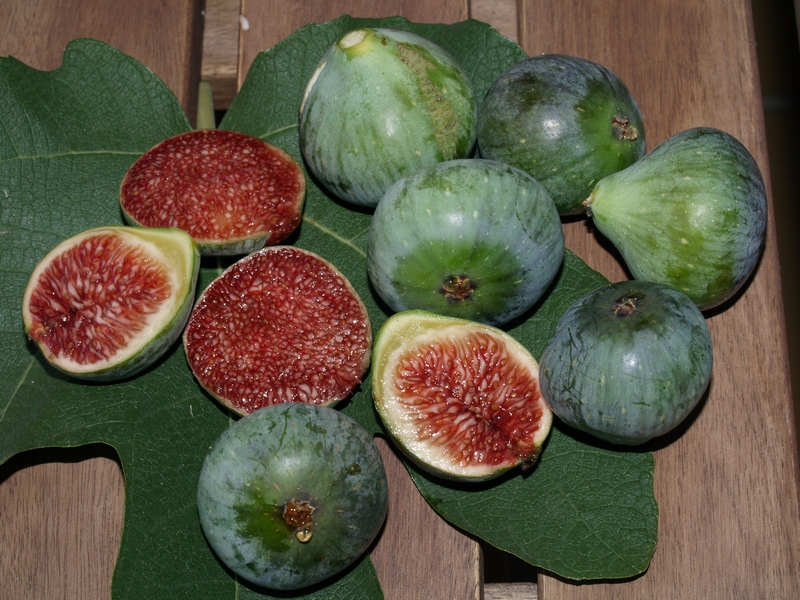This site contains affiliate links for which I may be compensated.
Verdal
Verdal Information


-
Possible Synonyms / AKA:
Verdala, Francesa, Grosse Verdale, Verdal Longue, Verdaleta, Agen D'Agen, Grosse du Draguignan, Ficus carica virescens Risso, SMN242IB -
Introduced By:
-
Origin:
Spain -
Main Flavor Group:
Adriatic - delivers a balanced sweetness with a refreshing, light flavor. It combines subtle berry-like notes. Yellow or green skin and usually red pulp, with more complex additional flavors developing when fully ripe. -
Family Group:
-
Fig Type:
Common - Self fertile and will grow anywhere conditions are suitable -
Cold Hardy:
N/A -
Container Variety:
N/A -
Easy Rooting:
N/A -
Main Season:
any -
Availability:
N/A -
Breba Crop:
N/A -
Seed Crunch:
N/A -
Eye:
small -
Skin Toughness:
N/A -
Fruit Size:
Medium -
Rain Resistance:
N/A -
Tree Vigor:
N/A -
External Links:
https://monserratpons.com/variedad/SMN242IB/
https://es.wikipedia.org/wiki/Verdaleta
Description
As mentioned by Galgoni:
Variety of late fig, one crop.
The fig tree is in the backyard (north) of a stately house, in the catalan region of “Maresme”, in front the sea.
This variety was described by Pere Estelrich i Fuster.
With a high probaliy it corresponds to the variety described by Giorgio Galesio in the pomona italiana: http://www.pomonaitaliana.it/pomona/fico_verdone.htm.
If that before is true it would correspond to the variety described by Ira Condit and they would be synonyms: .
Grosse Verte, Nebian, Adriatic, White Adriatic, Fico di Fragola, Strawberry.
There are other fig trees varieties with figs of the same color that can receive this name.
Medium size tree that grows slowing.
Leaves mostly of 5 lobules, few cutted. Fruit with a few flesh, meat red dark, sweet and flavorful is the many people opinion.
(according to Ira Condit it depends of the climates its color changes from the pink tones to the dark red).Green skin and resitant that gives its name.
The fig tree is in the backyard (north) of a stately house, in the catalan region of “Maresme”, in front the sea.
This variety was described by Pere Estelrich i Fuster.
With a high probaliy it corresponds to the variety described by Giorgio Galesio in the pomona italiana: http://www.pomonaitaliana.it/pomona/fico_verdone.htm.
If that before is true it would correspond to the variety described by Ira Condit and they would be synonyms: .
Grosse Verte, Nebian, Adriatic, White Adriatic, Fico di Fragola, Strawberry.
There are other fig trees varieties with figs of the same color that can receive this name.
Medium size tree that grows slowing.
Leaves mostly of 5 lobules, few cutted. Fruit with a few flesh, meat red dark, sweet and flavorful is the many people opinion.
(according to Ira Condit it depends of the climates its color changes from the pink tones to the dark red).Green skin and resitant that gives its name.
Condit Monograph
Verdal (syns. Verdala, Grosse Verdale, Verdal Longue, Agen D'Agen, Grosse du Draguignan, Ficus carica virescens Risso). Described by Risso (1826) under the appellation ''figue a' fruit vert'' (fig with green fruit). Sauvaigo (1889) described the same variety as Verdale or Grosse Verdale. Hogg (1866) treated D'Agen and ''Gros DE Draguignan'' as distinct varieties. Eisen (1888) gave ''Gros du Dragnignan,'' with Agen as a synonym; in 1901 he reversed the nomenclature, listing Grosse du Draguignan as the synonym, with the last name correctly spelled. Other accounts are by Audibert Freres (1854), Escribano y Perez (1884, probably), Barron (1891), Shinn (1893), Stubenrauch (1903), Sanchez (1922), Condit (1921b, 1947), Blin (1942); Simonet et al. (1945, as Verdale), and Soc. Pomol. DE France (1947). The spelling Verdal is used here to designate this variety, bearing green fruits tinged with violet, as distinct from Verte (syn. Verdale), bearing fruits of an over-all green color.
Risso stated that the fruits commenced to ripen in late June, but later writers regard it as a one-crop variety. Hogg reported it as ''one of the finest figs I know.'' Eisen also described it as ''one of the best figs,'' ripening very late, and ''requiring Caprification at Niles.'' It was introduced into Algeria (Trabut, 1904), and according to Plant Immigrants (No. 146, p. 1334), produced one crop of excellent figs from September to December. It may be this variety which Estelrich (1910) described and figured under the name Verdal DE Oriola.
According to Eisen (1901, p.66), Agen was one of the varieties imported by John Rock from England in 1883. P.I. No. 18,870 of the Chiswick collection was listed as D'Agen. Notes taken on this introduction in September, 1921, at the United States Plant Introduction Garden, Chico, California, showed a medium-sized, greenish-violet fig, excellent in quality and well worthy of further trial. The same variety was grown by the California Experiment Stations as Verdal Longue and distributed for trial, especially in southern California. Dooryard trees have been found at Oroville, Monrovia, Riverside, San Diego, and Carlsbad. About 1930, a grower at Carlsbad had a small commercial planting from which excellent figs were marketed up to Christmas, or even later. Cuttings were introduced into Georgia from California, but no record of production has been found. Fruiting trees were seen in a variety collection at Angleton,
Texas, in August, 1940. The following account is of trees and fruit grown at Riverside since 1931, and at Los Angeles during eight fruiting seasons. Tree somewhat spreading, with outer branches drooping; terminal buds green. Leaves medium, somewhat glossy above, mostly 5-lobed; both upper and lower sinuses of medium depth and width; base subcordate to truncate; margins very slightly crenate.
Brebas rare, medium, turbinate; stalk up to 3/4 inch long, curved; eye medium; white flecks large, conspicuous; color greenish violet; pulp strawberry; flavor rich.
Second-crop figs medium, up to 1-3/4 inches long and 1-7/8 inches in diameter, turbinate to obovate; with short, thick neck; average weight 43 grams; stalk thick, up to 1/2 inch long; ribs narrow, slightly elevated; eye medium, open, scales chaffy, tinged with violet; surface somewhat glossy, with prominent bloom; white flecks large, conspicuous; skin checking crisscross at maturity; color green, tinged with violet or light brown; meat thin, white; pulp strawberry; flavor rich; quality good. (Plate 26, C.)
Caprified figs medium to large, oblate-spherical; color attractive, greenish violet; bloom especially prominent; pulp solid, dark strawberry, rich in flavor. Considerably better in size, appearance, and quality than uncaprified fruit. Season late.
Verdal (syns. Verdala, Grosse Verdale, Verdal Longue, Agen D'Agen, Grosse du Draguignan, Ficus carica virescens Risso). Described by Risso (1826) under the appellation ''figue a' fruit vert'' (fig with green fruit). Sauvaigo (1889) described the same variety as Verdale or Grosse Verdale. Hogg (1866) treated D'Agen and ''Gros DE Draguignan'' as distinct varieties. Eisen (1888) gave ''Gros du Dragnignan,'' with Agen as a synonym; in 1901 he reversed the nomenclature, listing Grosse du Draguignan as the synonym, with the last name correctly spelled. Other accounts are by Audibert Freres (1854), Escribano y Perez (1884, probably), Barron (1891), Shinn (1893), Stubenrauch (1903), Sanchez (1922), Condit (1921b, 1947), Blin (1942); Simonet et al. (1945, as Verdale), and Soc. Pomol. DE France (1947). The spelling Verdal is used here to designate this variety, bearing green fruits tinged with violet, as distinct from Verte (syn. Verdale), bearing fruits of an over-all green color.
Risso stated that the fruits commenced to ripen in late June, but later writers regard it as a one-crop variety. Hogg reported it as ''one of the finest figs I know.'' Eisen also described it as ''one of the best figs,'' ripening very late, and ''requiring Caprification at Niles.'' It was introduced into Algeria (Trabut, 1904), and according to Plant Immigrants (No. 146, p. 1334), produced one crop of excellent figs from September to December. It may be this variety which Estelrich (1910) described and figured under the name Verdal DE Oriola.
According to Eisen (1901, p.66), Agen was one of the varieties imported by John Rock from England in 1883. P.I. No. 18,870 of the Chiswick collection was listed as D'Agen. Notes taken on this introduction in September, 1921, at the United States Plant Introduction Garden, Chico, California, showed a medium-sized, greenish-violet fig, excellent in quality and well worthy of further trial. The same variety was grown by the California Experiment Stations as Verdal Longue and distributed for trial, especially in southern California. Dooryard trees have been found at Oroville, Monrovia, Riverside, San Diego, and Carlsbad. About 1930, a grower at Carlsbad had a small commercial planting from which excellent figs were marketed up to Christmas, or even later. Cuttings were introduced into Georgia from California, but no record of production has been found. Fruiting trees were seen in a variety collection at Angleton,
Texas, in August, 1940. The following account is of trees and fruit grown at Riverside since 1931, and at Los Angeles during eight fruiting seasons. Tree somewhat spreading, with outer branches drooping; terminal buds green. Leaves medium, somewhat glossy above, mostly 5-lobed; both upper and lower sinuses of medium depth and width; base subcordate to truncate; margins very slightly crenate.
Brebas rare, medium, turbinate; stalk up to 3/4 inch long, curved; eye medium; white flecks large, conspicuous; color greenish violet; pulp strawberry; flavor rich.
Second-crop figs medium, up to 1-3/4 inches long and 1-7/8 inches in diameter, turbinate to obovate; with short, thick neck; average weight 43 grams; stalk thick, up to 1/2 inch long; ribs narrow, slightly elevated; eye medium, open, scales chaffy, tinged with violet; surface somewhat glossy, with prominent bloom; white flecks large, conspicuous; skin checking crisscross at maturity; color green, tinged with violet or light brown; meat thin, white; pulp strawberry; flavor rich; quality good. (Plate 26, C.)
Caprified figs medium to large, oblate-spherical; color attractive, greenish violet; bloom especially prominent; pulp solid, dark strawberry, rich in flavor. Considerably better in size, appearance, and quality than uncaprified fruit. Season late.
If you'd like your banner to be shown here and throughout Fig Database, send us a message.
Photos Add Your Image
YouTube Videos
No Videos Found






